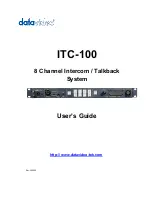
Problem
Cause
Solution
1. Power Light Not Illuminated
No AC power
Check GFI and incoming power
Debris stuck on Probe
Remove Probe and clean debris and any scale build-up off bars
Controller failure
Contact Dealer or Installer
2. Ionizing Light Illuminated Red
Probe exhausted
Inspect and replace Probe if exhausted
3. Ionization light flashing green or
not able to raise ionization level to
maximum bars
Insufficient water flow
through flow chamber
Make sure the Probe is receiving enough water flow. Make sure red dot on top of Probe fitting is in line with the direction
of the water flow through the flow chamber.
Move Probe to area of greater water flow. Plumbing into the water feature’s recirculating system is the most effective
method. If the Flow Chamber is set in the skimmer or pump vault you can remove the probe fitting from the Flow Chamber
and submerge the bare Probe into skimmer or pump vault. This will further improve flow across the Probe’s bars.
The red dot on the top of the Probe fitting indicates proper orientation of the Probe when installed into the Flow
Chamber. Make sure the red dot is lined up with the direction of the water flow through the Flow Chamber. Proper
orientation of the Probe will maximize the IonGen’s
™
performance.
(See Fig. 7 on page 4)
Debris stuck on Probe
Remove Probe and clean debris and any scale build-up off bars
4. Continued Scale Build-up
on Probe Bars
Insufficient water
flow across Probe
See #3 Ionization light flashing green or not able to raise ionization level to maximum bars.
5. Low Copper Level
Ionizing level set too low
Raise Ionizing level
Insufficient flow through
Flow Chamber
Increase pump run time or move Flow Chamber to higher flow location
Probe exhausted
Inspect and replace Probe if exhausted
6. High Copper Level
Ionizing level
set too high
Reduce ionizing indicator to 1 bar or unplug Control Panel until copper level is below 0.25 ppm.
A partial water change can also be conducted for quicker copper level decrease.
7. Cloudy Water/Excessive Debris
Low copper level
Raise ionization level
Insufficient flow through
Flow Chamber
Increase pump run time or move Flow Chamber to higher flow location
Debris stuck on Probe
Remove Probe and clean debris and any scale build-up off bars
Outside of targeted
water parameters
See Targeted Water Parameters table
5
Fig. 12
Fig. 13
Example of a
deteriorated probe.
ImPOrTANT:
Before starting the IonGen
™
on existing water features, it is recommended to thoroughly clean the pond of as much debris as
possible. This will maximize the ion’s effectiveness, speed to achieve desired results and ability to raise the ions up to the proper level. The more
debris and dirtier the water feature, the longer it will take for the IonGen
™
to provide noticeable results.
• It is recommended to shut
down the IonGen
™
System
in regions that have climates
that experience cold-freezing
temperatures. This will help
save the life of the probe for
the warmer months.
• The Control Panel is weather
resistant, but steps to protect
it from the elements, such as
mounting the panel above the
ground, are recommended to
maximize its lifespan.
• The Flow Chamber, when
plumbed directly into the
recirculating system, needs to be
located in a region that will drain
for servicing the replaceable
IonGen
™
Probe, as well as
allowing the Flow Chamber
fitting to over-winter.
• If shutting down the water
feature during the winter, make
sure the plumbing line is drained
free of water. Failure to do this
may cause water remaining
in the plumbing line to freeze,
potentially cracking the
Flow Chamber.
• The Flow Chamber, when set
in the skimmer or inside the
pond, should be removed
and stored inside.
• Prior to restarting the IonGen
™
it is a good idea to remove and
inspect the Probe to make sure
it is free of debris and scale
build-up and not close to being
exhausted. Scrape away any scale
build-up from the Probe’s bars.
Replace Probe if it appears to be
close to exhausted.
(See Fig. 13)
Winterization
Troubleshooting Guide
replacing the Probe
Disconnect the waterproof
connector at the top of the
Flow Chamber and remove
and inspect the IonGen
™
Probe for
significant deterioration. Replace if
necessary.
(See Fig. 12 and 13)
Note:
It is good practice once a
year or at the beginning of the
water garden season to manually
inspect the IonGen
™
Probe.
Clean off any debris or scale
build-up during inspection.
Continued on page 6






























